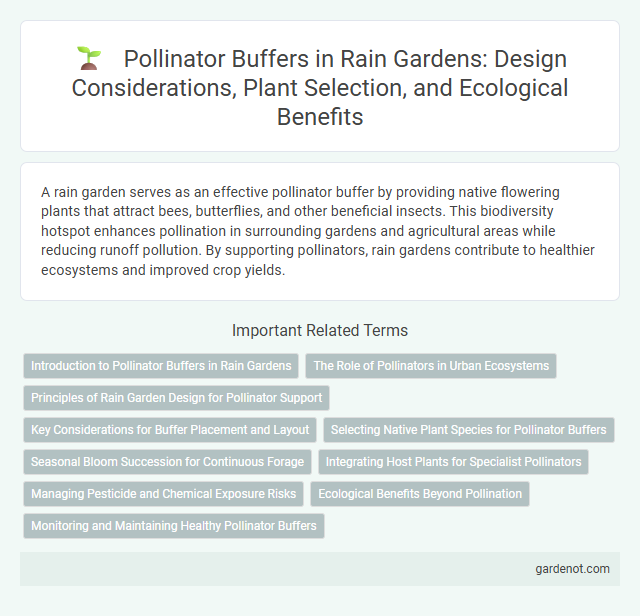A rain garden serves as an effective pollinator buffer by providing native flowering plants that attract bees, butterflies, and other beneficial insects. This biodiversity hotspot enhances pollination in surrounding gardens and agricultural areas while reducing runoff pollution. By supporting pollinators, rain gardens contribute to healthier ecosystems and improved crop yields.
Introduction to Pollinator Buffers in Rain Gardens
Pollinator buffers in rain gardens are strategically planted zones designed to attract and support pollinators such as bees, butterflies, and hummingbirds. These buffers use native flowering plants that provide essential nectar and pollen resources, enhancing biodiversity and promoting ecosystem health within urban and suburban landscapes. Incorporating pollinator buffers into rain gardens improves water quality by filtering pollutants while creating critical habitat for declining pollinator populations.
The Role of Pollinators in Urban Ecosystems
Pollinator buffers in rain gardens create vital habitats that support essential pollinators such as bees, butterflies, and hummingbirds, which play a critical role in urban ecosystem health by enhancing plant reproduction and biodiversity. These buffers improve pollination efficiency for native and ornamental plants, contributing to increased green space productivity and urban food security. Preserving pollinator populations within rain gardens helps mitigate the negative impacts of habitat loss and pollution in densely built environments.
Principles of Rain Garden Design for Pollinator Support
Rain gardens designed with pollinator support emphasize diverse native plant species that provide continuous bloom cycles, ensuring food availability throughout the growing season. Proper soil amendments and strategic placement improve water infiltration and prevent runoff, creating an ideal habitat for pollinators like bees, butterflies, and hummingbirds. Incorporating structural diversity with layers of ground covers, perennials, and shrubs enhances shelter and nesting opportunities, crucial for sustaining robust pollinator populations.
Key Considerations for Buffer Placement and Layout
Pollinator buffers in rain gardens should be strategically placed where they maximize habitat connectivity and protect pollinator activity from pesticide exposure and habitat disturbance. Optimal buffer layout incorporates diverse native flowering plants that bloom sequentially to support a range of pollinator species throughout the growing season. Ensuring adequate sunlight, proximity to water sources, and minimizing human or pet traffic enhances pollinator foraging and nesting opportunities.
Selecting Native Plant Species for Pollinator Buffers
Selecting native plant species for pollinator buffers in rain gardens enhances local biodiversity and supports pollinator health by providing essential nectar and pollen sources. Native plants are well-adapted to the local climate and soil conditions, improving water infiltration and reducing maintenance requirements. Incorporating a diverse mix of flowering plants with staggered bloom periods ensures continuous food supply for pollinators throughout the growing season.
Seasonal Bloom Succession for Continuous Forage
Pollinator buffers in rain gardens are designed to support seasonal bloom succession, providing continuous forage throughout the growing season. Incorporating a diverse mix of native flowering plants like asters, coneflowers, and milkweed ensures a steady supply of nectar and pollen for bees, butterflies, and other pollinators from spring through fall. This strategy enhances pollinator habitat connectivity and promotes ecosystem resilience by sustaining pollinator populations year-round.
Integrating Host Plants for Specialist Pollinators
Integrating host plants for specialist pollinators in rain garden pollinator buffers enhances biodiversity by providing essential resources for species with specific plant dependencies. Selecting native plants such as milkweed for monarch butterflies or goldenrod for certain bee species supports their life cycles and promotes ecological resilience. This targeted planting strategy strengthens pollinator populations and improves overall ecosystem health within urban landscapes.
Managing Pesticide and Chemical Exposure Risks
Rain gardens planted with native flowering species create effective pollinator buffers that reduce pesticide and chemical exposure by filtering runoff before it reaches pollinator habitats. Proper designing of these gardens incorporates soil amendments and vegetation layers that enhance the degradation of harmful chemicals, protecting bees, butterflies, and other vital pollinators. Regular monitoring and avoiding pesticide applications near rain garden perimeters further manage and minimize the risk of contamination within these ecological buffers.
Ecological Benefits Beyond Pollination
Rain gardens serving as pollinator buffers create microhabitats that support diverse insect populations, enhancing overall biodiversity. These green spaces contribute to soil health by promoting microbial activity and nutrient cycling, which improves water quality through natural filtration. By stabilizing local ecosystems, rain gardens mitigate urban heat island effects and support resilience against climate change.
Monitoring and Maintaining Healthy Pollinator Buffers
Regular monitoring of pollinator buffers involves tracking plant diversity, bloom timing, and pollinator activity to ensure ecosystem health and resilience. Maintaining these buffers requires timely removal of invasive species, supplemental planting of native flowering plants, and managing soil moisture levels to support robust pollinator populations. Consistent data collection and adaptive management practices enhance the effectiveness of pollinator buffers in supporting biodiversity and improving water quality in rain garden systems.
Pollinator buffer Infographic

 gardenot.com
gardenot.com